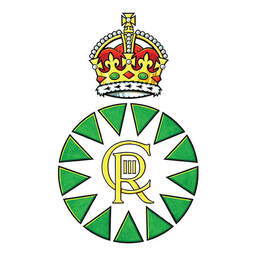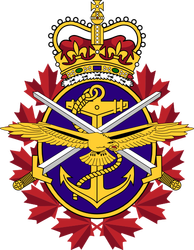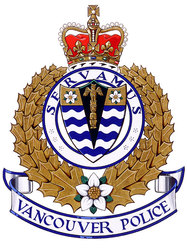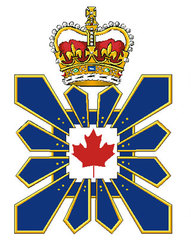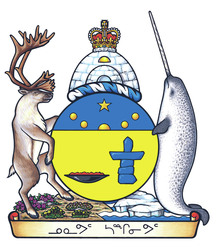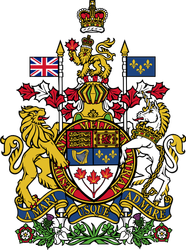The King of Canada

His Majesty King Charles III, King of Canada
The King of Canada embodies the Canadian State, as well as being bound in numerous Treaty and other Crown-Indigenous relationships across the land.
This means that the personification (human face) of the Canadian state is the King. The King (aka monarch, sovereign) represents the Canadian Crown - an institution that has evolved in this country since the 15th century. The King represents Canada's sovereignty and gives authority to its institutions - all things are done in His Majesty's name whether it is creating new laws or issuing someone a parking ticket.
It is important to stress that Charles III in no way links Canada (politically or militarily) to the United Kingdom - The King of the United Kingdom and The King of Canada are two separate roles even though they are filled by the same person.
Charles III assumed the title "King of Canada" automatically following the death of his mother on September 8th, 2022.
On January 31st, 2024, following an Act of Parliament, the Governor General, made an official change to the King’s title in Canada by proclaiming him::
In English: Charles the Third, by the Grace of God King of Canada and His other Realms and Territories, Head of the Commonwealth.
In French: Charles Trois, par la grâce de Dieu, Roi du Canada et de ses autres royaumes et territoires, Chef du Commonwealth.
*Read "What's a Monarchy For?" (Letter from Governor General David Johnston to Deborah Vujlsteke) on pages 149-154 in The Idea of Canada (Toronto: McClelland & Stewart, 2016) to see what former Governor General David Johnston thought about the value of Canada's constitutional monarchy.
Learn more about Queen Elizabeth II (reigned 1952-2022):
| Queen Elizabeth II, 1952-2022 (2023) | |
| File Size: | 1292 kb |
| File Type: | |
| The Separate Commonwealth Realms.pdf | |
| File Size: | 693 kb |
| File Type: | |
| The Kings and Queens of Canada - a poster created by the Department of Canadian Heritage.pdf | |
| File Size: | 10072 kb |
| File Type: | |
On paper, the King holds a tremendous amount of power, but because he must observe the rules laid out by our constitution and democratic traditions (i.e. the convention of responsible government), he is not able to exercise them without the advice of elected officials. The King holds absolute authority and power, but he must lend them to those elected by the public. Still, the King has very important rights in our system of government:
The right to be consulted; The right to encourage; and The right to warn
Recently another power of the Crown has been recognized: The power to convene (bring people together)
While the King cannot use the tremendous powers of the Crown without advice, he exists as a safety mechanism from those elected officials who might abuse their positions in government. Put simply, the Crown is the only thing that can be used to remove someone who is misusing the powers entrusted to them from the Crown.
Treaty and other critical Crown-Indingeous Relationships are unique to the various Nations in which the Crown is bound. Giima Stacey Laforme of the Mississaugas of the Credit Nation (our Treaty partner) said in 2016: ". . . treaties cannot be understood without acknowledging the personal bonds Indigenous Peoples have with the Queen and her family."
As National Chief of the Assembly of First Nations, Perry Bellegarde said in 2019, "Properly understood, the Treaty relationship is not founded in rights denial or a colonial mentality but, rather, in the equality and sovereignty of peoples and our agreement to share the land without dominating one another . . . While the government of the day has a role to operationalize the Treaty obligations held by the Crown, the [King's] representatives are the caretakers and witnesses to this immutable relationship."
Visit the Government of Canada's website on the Canadian Crown here.
Visit His Majesty The King's personal website here.
The right to be consulted; The right to encourage; and The right to warn
Recently another power of the Crown has been recognized: The power to convene (bring people together)
While the King cannot use the tremendous powers of the Crown without advice, he exists as a safety mechanism from those elected officials who might abuse their positions in government. Put simply, the Crown is the only thing that can be used to remove someone who is misusing the powers entrusted to them from the Crown.
Treaty and other critical Crown-Indingeous Relationships are unique to the various Nations in which the Crown is bound. Giima Stacey Laforme of the Mississaugas of the Credit Nation (our Treaty partner) said in 2016: ". . . treaties cannot be understood without acknowledging the personal bonds Indigenous Peoples have with the Queen and her family."
As National Chief of the Assembly of First Nations, Perry Bellegarde said in 2019, "Properly understood, the Treaty relationship is not founded in rights denial or a colonial mentality but, rather, in the equality and sovereignty of peoples and our agreement to share the land without dominating one another . . . While the government of the day has a role to operationalize the Treaty obligations held by the Crown, the [King's] representatives are the caretakers and witnesses to this immutable relationship."
Visit the Government of Canada's website on the Canadian Crown here.
Visit His Majesty The King's personal website here.
Proclamation of Charles III as King of Canada - September 10th, 2022
A Grant of Arms
One of the powers of the Crown is to grant a person, company, institution or corporate body a Grant of Arms (aka Coat of Arms). Coats of Arms act as visual representations of their holders. Look below at some coats of arms from across Canada - notice where the Crown is shown (representing where they each receive authority). Learn more about the ancient art of Heraldry by visiting the Canadian Heraldic Authority.
The Governor General of Canada

The Rt Hon Mary Simon,
Governor General of Canada
The Governor General represents the King of Canada. As the King's Representative, the Governor General performs many important functions for the country. Learn more here.
*Read "An Individual Institution" (Letter from Governor General David Johnston to Jacques Monet sj) on pages 87-91 in The Idea of Canada (Toronto: McClelland & Stewart, 2016) to see what a former governor general thought of his role in Canada.
*Read "An Individual Institution" (Letter from Governor General David Johnston to Jacques Monet sj) on pages 87-91 in The Idea of Canada (Toronto: McClelland & Stewart, 2016) to see what a former governor general thought of his role in Canada.
The Lieutenant Governor - The King's Provincial Representative
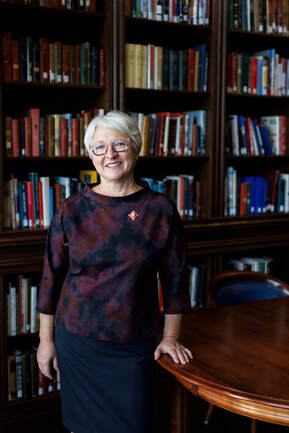
The Hon. Edith Dumont, 30th Lieutenant Governor of Ontario
In addition to the Governor General, The King also has a representative in each province. The role of the Lieutenant Governor is to represent The King in provincial matters, as well as protect the rights and privileges of their province within the Canadian state. The Provincial Crown exists to both unify the country, as well as reinforce the fact that each province is unique and a politically separate part of the state.
Visit the website of the Lieutenant Governor of Ontario here.
Visit the website of the Lieutenant Governor of Ontario here.
The Hon. Antionette Perry, Lieutenant Governor of Prince Edward Island, explores the critical role of her office in life of her province
How Ontario gets its Premier - From the Office of the Lieutenant Governor of Ontario
|
|
| ||||||||||||||||||
* This same process is used to select the Canadian prime minister (the federal representative of the King is the Governor General)
Visual example of the Canadian State - the Speech from the Throne
Important Parliamentary Officers and Officials
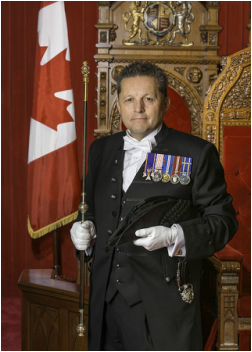
Usher of the Black Rod in the Senate
Speaker - One of the most important officials of our Parliament. The Speaker acts as a referee and is charged with maintaining order and observing proper procedures - both the Senate and the House of Commons have a Speaker. The Speaker of the Senate is appointed by the Governor General on the recommendation of the Prime Minister while The Speaker of the House of Commons is a Member of Parliament chosen through a secret ballot by his peers in the chamber.
Website for The Speaker of the Senate
Website for The Speaker of the House of Commons
Rick Mercer Report - Rick as the Speaker (Feb 2011)
Clerks of The Senate and Clerks of the Parliaments - The Clerk of the Senate manages the Senate’s day-to-day operation. The Clerk also supports all aspects of the legislative process, from the swearing-in of new Senators to advising the Speaker on parliamentary procedure and interpretation of the rules. As Clerk of the Parliaments, the Clerk is custodian of all original Acts and is responsible for certifying true copies of these Acts. More information can be found here.
Clerk of the House - The Clerk of the House of Commons is the chief procedural advisor to the Speaker and MPs. The Clerk also has extensive duties related to the overall management of the House of Commons.
Sergeant-at-Arms - The Sergeant-at Arms assists the Clerk as head of parliamentary precinct services, performing certain ceremonial functions and being responsible for security and building services. It is the Sergeant-at-Arms who handles the mace (symbols of Royal Authority in both Houses of Parliament).
Usher of the Black Rod in the Senate - Responsible for security in the Senate and parliamentary ceremonies and traditions, 'Black Rod' is a position steeped in history. The current Black Rod is Superintendent J. Greg Peters MVO.
Click here to find out all the current officers and officials of Parliament
Overall Expectations addressed (2022):
B2. Canadian and Indigenous Governance Systems: explain, with reference to a range of issues of civic importance, the roles and responsibilities of various institutions, structures, and positions in Canadian and Indigenous governance systems, treaty relationships, and other Crown-Indigenous relations.

